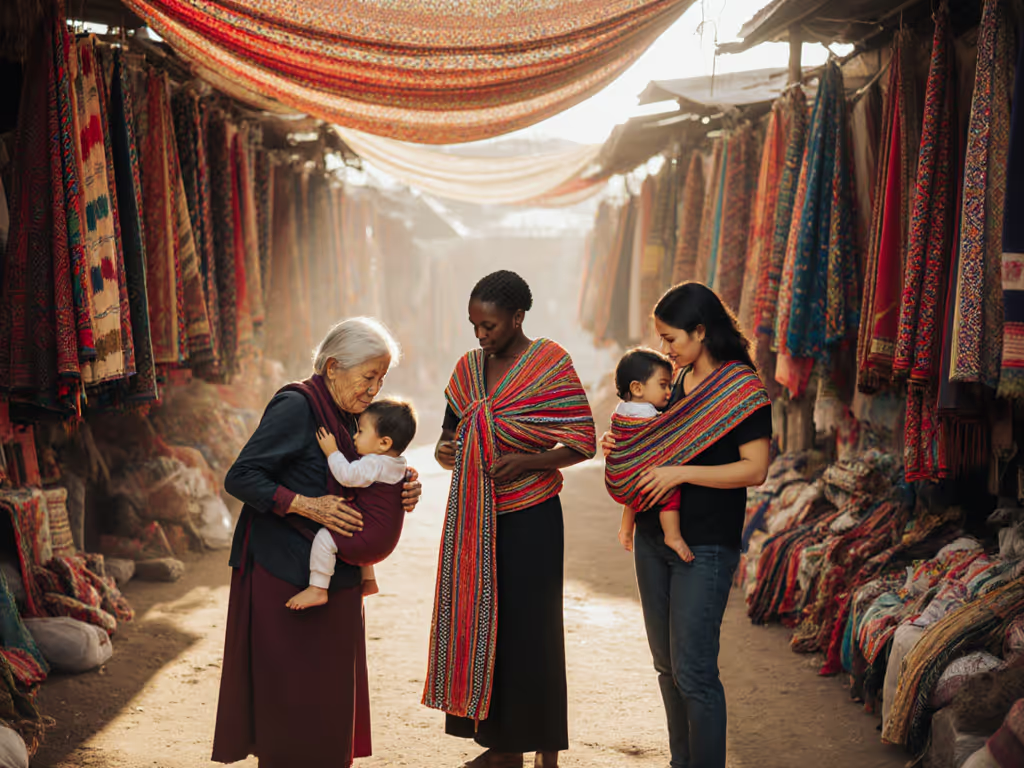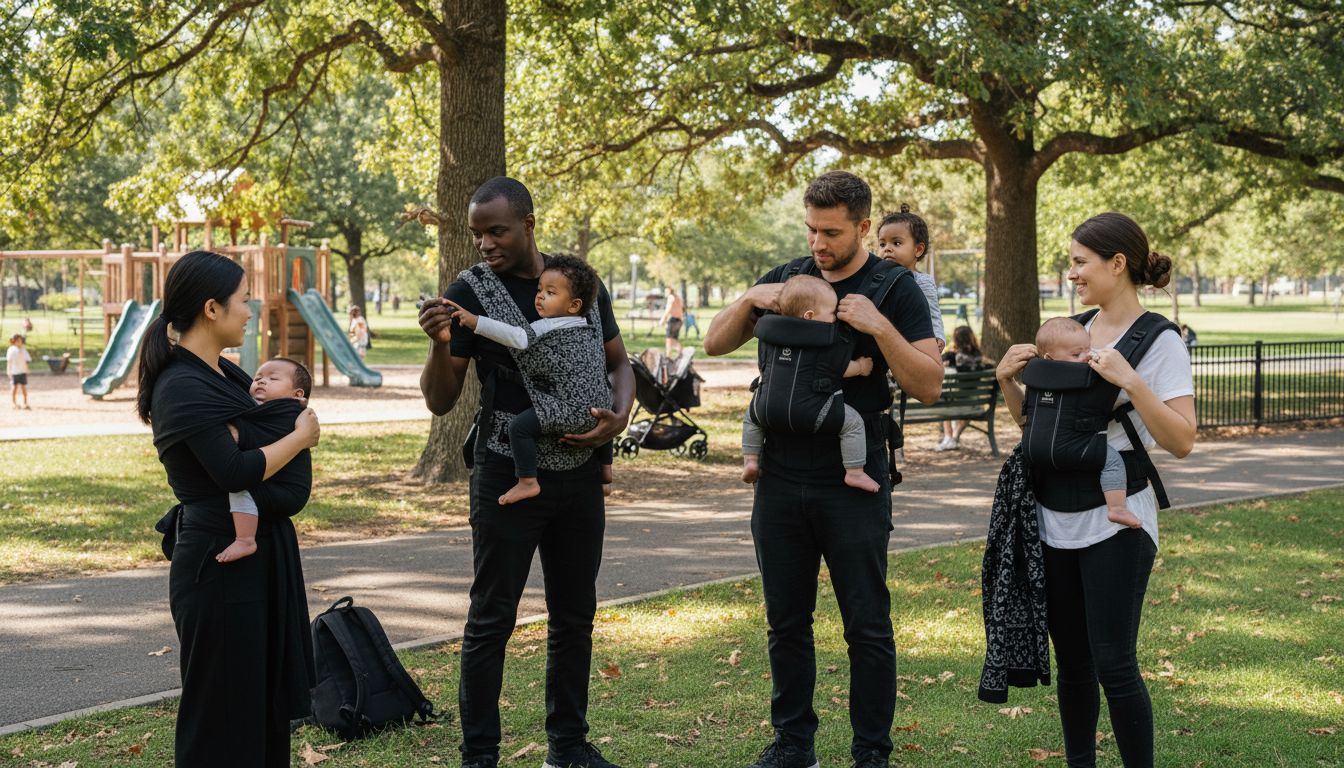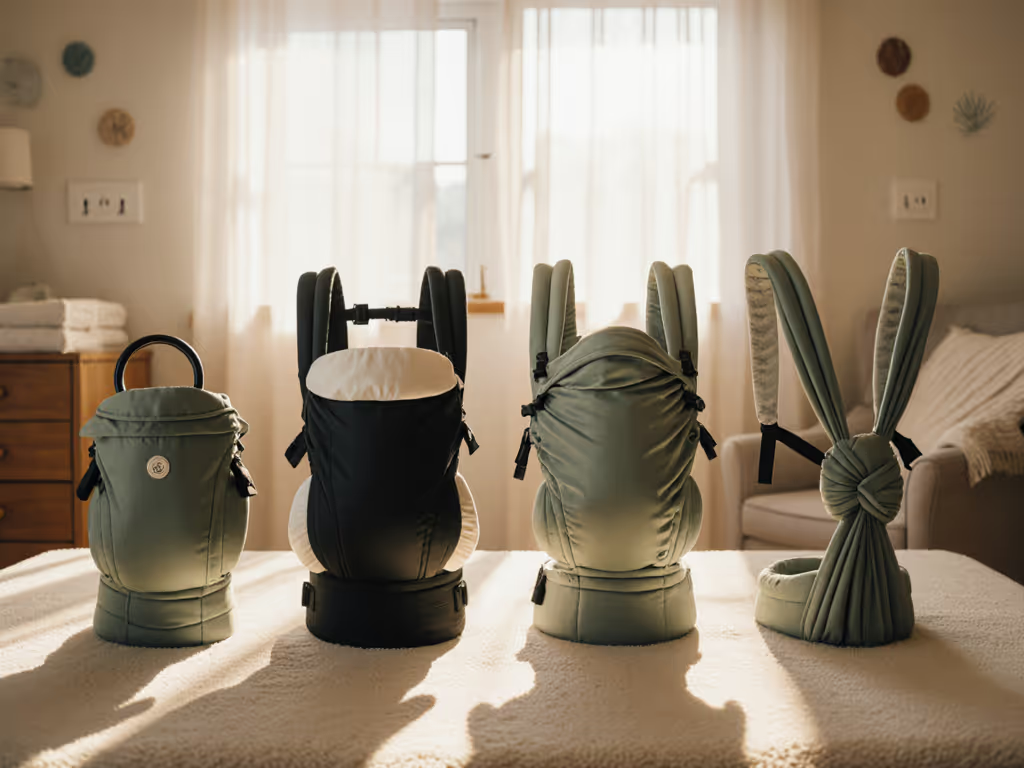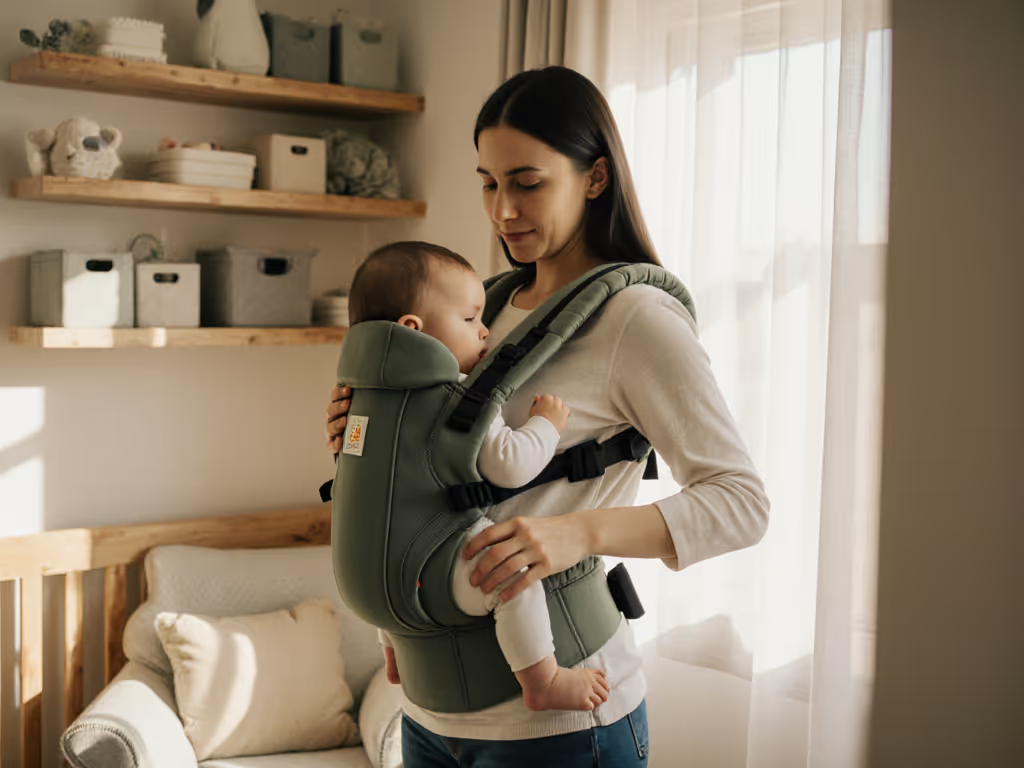
Babywearing Terminology 2025: Complete Guide

Over 60 percent of new parents now use babywearing for daily caregiving, making it a major trend in infant care. This rise matters because the words we use shape how parents understand both safety and the deep bonds formed through close contact. For anyone seeking clarity, knowing modern babywearing terminology unlocks smarter choices that promote comfort, security, and healthy child development.
Key Takeaways
| Point | Details |
|---|---|
| Evolving Terminology | Babywearing now embodies a holistic approach, emphasizing not just convenience but also emotional and physiological benefits for both caregiver and child. |
| Variety of Carriers | Understanding different carrier types and their specific functions can enhance caregiver and infant comfort and safety. |
| Safety Practices | Adhering to the T.I.C.K.S. rule ensures safe babywearing, focusing on positioning and visibility to promote infant well-being. |
| International Standards | Updated global safety standards reflect a comprehensive view of infant care, integrating biomechanical and developmental safety principles. |
Defining Babywearing Terminology for 2025
Babywearing is more than just carrying an infant – it's a dynamic parenting practice that transforms how caregivers interact with their youngest family members. At its core, babywearing refers to the intimate method of transporting babies and young children using specialized cloth carriers that keep infants securely attached to an adult's body.
The fundamental terminology around babywearing has evolved significantly, reflecting a growing understanding of infant development and caregiver needs. Carrier types now encompass a wide range of designs, each serving unique purposes:
- Wrap Carriers: Long fabric pieces that wrap around the caregiver's body, offering maximum flexibility
- Soft Structured Carriers: Structured designs with buckles and padded straps for structured support
- Ring Slings: Quick-adjust fabric carriers with metal or plastic rings for customized positioning
- Mei Tais: Traditional Asian-inspired carriers combining fabric wrapping with structured shoulder straps
Beyond basic transportation, modern babywearing terminology recognizes the profound physiological and psychological benefits. Bonding, skin-to-heart contact, and neurological development are now central concepts in understanding why this practice has gained tremendous popularity. Caregivers aren't just moving their children – they're creating neurological pathways, regulating infant stress responses, and building deep emotional connections through physical proximity.
As we move into 2025, babywearing terminology continues to reflect a holistic approach to infant care. It's no longer just about convenience, but about creating intentional, responsive parenting experiences that support both caregiver and child's physiological and emotional well-being. The language we use now emphasizes not just the mechanical aspects of carrying, but the profound developmental interactions happening during these intimate moments.
Types of Baby Carriers and Carry Styles
Baby carriers represent a diverse ecosystem of design innovations, each tailored to meet the unique needs of caregivers and infants. Understanding the nuanced differences between carrier types can help parents select the most comfortable and supportive option for their specific lifestyle and physical requirements.
Primary Carrier Categories
Modern babywearing offers several fundamental carrier types, each with distinct characteristics:
Here's a comparison of the main types of baby carriers and their key characteristics:
| Carrier Type | Structure & Adjustability | Common Uses | Notable Advantages |
|---|---|---|---|
| Wrap Carrier | Long fabric, fully adjustable | Newborns<br>Skin-to-skin | Versatile<br>Custom fit |
| Ring Sling | Single fabric, ring adjusters | Short trips<br>Quick carry | Fast setup<br>Lightweight |
| Soft Structured Carrier | Buckles, padded straps | Daily activities<br>Long wear | Ergonomic support<br>Padded comfort |
| Mei Tai | Tied fabric + structured straps | Versatile carrying positions | Blend of wrap & structure |
| Pouch Sling | Pre-sewn, not adjustable | Minimal carrying<br>Quick use | Simple design<br>Compact |
- Wrap Carriers: Versatile fabric lengths allowing multiple wrapping configurations
- Ring Slings: Quick-adjust, lightweight carriers ideal for short trips
- Soft Structured Carriers: Ergonomic designs with padded straps and waistbands
- Mei Tai Carriers: Traditional Asian-style carriers blending structured support with fabric flexibility
- Pouch Slings: Simple, non-adjustable carriers for minimal carrying needs
Carry Positioning Strategies
Carry styles are equally important as carrier types, with each position offering unique benefits for infant development and caregiver comfort. Infant positioning ranges from:
- Newborn Facing-In Position: Provides maximum head and neck support
- Hip Carry: Allows older infants to observe surroundings while maintaining close contact
- Back Carry: Enables hands-free movement for active caregivers
- Facing-Out Position: Stimulates visual and sensory exploration for more developed infants
The evolution of carrier designs reflects a growing understanding of biomechanical support and infant ergonomics.
 Modern carriers prioritize weight distribution, spine alignment, and hip positioning to ensure both caregiver comfort and infant safety. Sophisticated designs now integrate adjustable features, breathable materials, and ergonomic structures that adapt to changing body shapes and developmental stages.
Modern carriers prioritize weight distribution, spine alignment, and hip positioning to ensure both caregiver comfort and infant safety. Sophisticated designs now integrate adjustable features, breathable materials, and ergonomic structures that adapt to changing body shapes and developmental stages.
As babywearing continues to gain popularity, carrier technologies are becoming increasingly specialized. Manufacturers now consider factors like climate adaptability, activity levels, and individual body types when designing carriers. The result is a rich marketplace of options that transform carrying from a simple transportation method into a nuanced, supportive interaction between caregiver and child.
Key Safety Terms and Positioning Concepts
Babywearing safety is a critical aspect of infant care that goes far beyond simple carrying techniques. Understanding key safety terminology and positioning concepts can mean the difference between a comfortable, secure experience and potential risk for both caregiver and child.
The T.I.C.K.S. Safety Rule
One of the most fundamental safety frameworks in babywearing is the T.I.C.K.S. rule, which provides a comprehensive checklist for safe carrying:
- Tight: Carrier should be snug enough to hold baby close with minimal movement
- In View: Baby's face should always be visible and unobstructed
- Close Enough to Kiss: Baby's head should be close enough to easily kiss
- Keep Chin Off Chest: Ensure baby's airway remains open and uncompressed
- Supported Back: Maintain a natural, rounded spine position
Ergonomic Positioning Concepts
Proper infant positioning is crucial for healthy physical development. The 'M' position has emerged as a gold standard for carrier ergonomics:
- Knee Height: Baby's knees should be positioned higher than their bottom
- Hip Alignment: Wide leg spread supports natural hip joint development
- Spine Curvature: Maintains natural C-shaped spinal curve
- Weight Distribution: Ensures even pressure across caregiver's body
Beyond physical positioning, modern safety terminology emphasizes neurological support and developmental considerations. Carriers are now evaluated not just for structural integrity, but for their ability to support infant sensory integration, muscle development, and emotional regulation.
 Sophisticated designs incorporate breathable materials, adjustable features, and ergonomic structures that adapt to a child's changing developmental stages.
Sophisticated designs incorporate breathable materials, adjustable features, and ergonomic structures that adapt to a child's changing developmental stages.
As babywearing continues to evolve, safety concepts are becoming increasingly nuanced. Caregivers are now encouraged to think holistically about carrier selection, considering factors like individual infant physiology, activity levels, and specific environmental conditions. The goal is no longer just safe transportation, but creating a dynamic, supportive interface that promotes optimal physical and emotional growth.
International Standards and Updated Guidelines
Baby carrier standards have undergone significant transformation, reflecting a global commitment to infant safety and caregiver education. As technology and research advance, international organizations are collaborating to develop comprehensive guidelines that address the complex needs of modern families.
Global Safety Collaboration
The Baby Carrier Industry Alliance has been instrumental in establishing evidence-based standards that transcend regional boundaries. Key developments in international guidelines include:
- Comprehensive Testing Protocols: Rigorous evaluation of carrier materials, structural integrity, and load-bearing capabilities
- Ergonomic Performance Standards: Detailed specifications for infant positioning and support
- Material Safety Certification: Strict requirements for chemical composition and potential allergen content
- Age and Weight Categorization: Precise guidelines for carrier usage across different developmental stages
Key Regulatory Focus Areas
International standards now encompass multiple dimensions of babywearing safety:
- Structural Integrity Testing: Assessing carrier strength under various stress conditions
- Biomechanical Alignment Criteria: Ensuring optimal support for infant spine and hip development
- Respiratory Safety Measurements: Evaluating carrier designs that maintain clear infant airways
- Temperature and Material Breathability Standards: Monitoring heat exchange and comfort levels
The evolution of these guidelines reflects a holistic approach to infant transportation. Modern standards go beyond simple mechanical specifications, incorporating insights from pediatric biomechanics, child psychology, and ergonomic research. Regulatory bodies are now considering not just immediate safety, but long-term developmental implications of carrier design and usage.
As we move into 2025, international standards continue to prioritize a nuanced understanding of infant care. The collaborative approach between industry experts, healthcare professionals, and safety regulators ensures that babywearing guidelines remain dynamic, responsive, and deeply rooted in scientific understanding. The goal is no longer just preventing immediate risks, but actively supporting optimal physical and neurological development through carefully designed carrying solutions.
Common Mistakes and Misused Terms
Babywearing terminology is complex and often misunderstood, leading to potentially dangerous misconceptions about infant carrying practices. Navigating the landscape of carrier use requires careful attention to specific language and precise understanding of safety principles.
Frequently Misinterpreted Terminology
Several terms and concepts are routinely misused or misunderstood by caregivers:
- "Cradle Hold": Historically popular but now recognized as potentially dangerous due to airway obstruction risks
- "Facing Out": Often misapplied before infant has sufficient neck strength
- "Hip Carry": Frequently confused with improper positioning that doesn't support natural hip development
- "Ergonomic": Overused marketing term that doesn't always guarantee proper biomechanical support
Critical Positioning Misconceptions
Common mistakes in carrier usage stem from fundamental misunderstandings:
- Incorrect Hip Support: Carriers that don't maintain the recommended 'M' position can compromise infant hip development
- Spine Alignment Errors: Failing to support natural infant spinal curvature
- Respiratory Risk Positions: Creating scenarios where infant's chin can compress against chest
- Weight Distribution Mistakes: Improperly adjusting carrier to caregiver's body type
Professional educators emphasize that terminology matters. What might seem like a minor semantic difference can represent significant safety implications. For instance, describing a carrier as 'comfortable' is far less meaningful than specifying its ability to maintain proper infant spine alignment and provide consistent weight distribution.
As babywearing continues to evolve, the complexity of its language reflects the nuanced understanding of infant physiological needs. Caregivers are increasingly encouraged to move beyond surface-level descriptions and critically evaluate carrier features. The most informed users understand that safety isn't just about following rules, but comprehending the underlying biomechanical principles that protect infant development.
Master Babywearing Safety and Comfort with Caregiver Carry
Understanding the evolving babywearing terminology of 2025 can be overwhelming. From mastering the T.I.C.K.S safety rule to selecting the right carrier that supports the critical 'M' position for your baby, caregivers face many challenges. You want to ensure your child’s health, proper spine alignment, and emotional bonding without sacrificing comfort or safety. These concerns are real and deserve clear, accessible answers built on solid evidence and expert guidance.
At Caregiver Carry, we empower you to confidently navigate this complex landscape. Our detailed guides break down carrier types and safe positioning techniques so you can choose what fits your lifestyle and your baby's unique needs. Discover how to avoid common mistakes like improper hip support or respiratory risks with our trusted resources. Ready to enhance your babywearing journey with safety and comfort? Explore our comprehensive babywearing resources and start making informed choices today. Don’t wait to give your little one the best start and build a stronger bond through intentional carrying.
Frequently Asked Questions
What are the different types of baby carriers available?
Baby carriers include wrap carriers, ring slings, soft structured carriers, Mei Tais, and pouch slings. Each type offers unique features and benefits tailored to various carrying needs.
How should I position my baby in a carrier for optimal safety?
Adhere to the T.I.C.K.S. safety rule: keep the carrier tight, ensure the baby is in view, maintain closeness to kiss, keep the chin off the chest, and support the baby's back properly.
What does the 'M' position mean in babywearing?
The 'M' position refers to the ideal placement of a baby's legs and hips while in a carrier: knees should be higher than the bottom, ensuring proper hip development and natural spinal curvature.
What are common mistakes to avoid when using a baby carrier?
Avoid incorrect hip support, failing to maintain spine alignment, misplacing the baby's head position leading to airway obstruction, and improper weight distribution on the caregiver's body.




